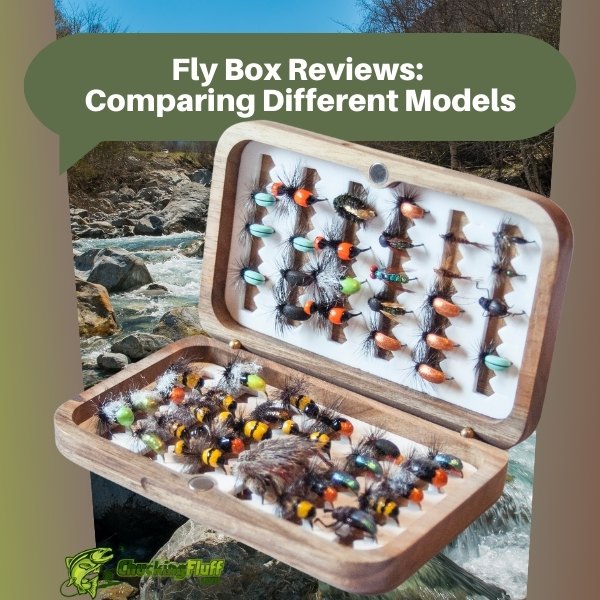| Disclosure: Just to be open and honest the buttons and links you click on in the website will in most cases take you to another website where you can purchase the products I am reviewing. As an Amazon Associate I earn from qualifying purchases. |
Fly Box Reviews: Comparing Different Models

If you’re a passionate angler, you know that your fly box is like your fishing companion, safeguarding your flies and keeping them organized for easy access. But with so many types of fly boxes on the market, each offering unique features, how do you choose the right one? This comprehensive review will dive deep into different fly box models, materials, and key features to help you find a box that complements your fishing style perfectly.
Quick Post Navigation
Types of Fly Boxes
Traditional vs. Modern Fly Boxes
Traditional fly boxes have a classic look, often made from metal or wood, with compartments to keep flies separate. Modern fly boxes, on the other hand, embrace lighter materials like plastic and silicone. They often feature magnetic or slotted foam inserts, offering more security and organization. Modern boxes also lean towards being more water-resistant, which can be essential depending on your fishing environment.
Waterproof Fly Boxes
Waterproof fly boxes are indispensable for anglers who fish in humid environments or close to water. These boxes often have rubber seals around the edges, ensuring that no water sneaks inside. They’re perfect if you tend to wade deep or get caught in the occasional downpour. The waterproof feature not only keeps your flies dry but also prevents mold and rust.
Double-Sided vs. Single-Sided Fly Boxes
Double-sided fly boxes maximize storage without adding bulk, allowing you to carry twice as many flies. This design is excellent for anglers with diverse collections or those switching between fly types frequently. Single-sided boxes, however, are usually more compact and may suit those who prioritize minimalism.
Specialty Fly Boxes (Foam, Magnetic, etc.)
Specialty fly boxes cater to specific needs. Foam fly boxes, for instance, use slotted or grooved foam to hold flies securely. Magnetic boxes are convenient for smaller flies as they prevent them from shifting around. These specialty options are ideal if you know your fly type and storage preferences.
Materials Used in Fly Boxes
Plastic Fly Boxes
Plastic is the go-to material for lightweight and affordable fly boxes. Many plastic models are durable and water-resistant, though lower-quality plastic may degrade over time with heavy sun exposure. High-quality plastic boxes provide a great balance of weight and durability.
Aluminum Fly Boxes
Aluminum fly boxes are known for their durability and classic look. They tend to be more robust and offer a certain level of water resistance, though they can be more prone to rust in saltwater settings. Many aluminum models feature foam or silicone inserts, providing modern functionality with a vintage feel.
Silicone Inserts and Foam Lining
Silicone and foam inserts add a layer of convenience and security by keeping flies firmly in place. Silicone holds up better over time, while foam can degrade with frequent use. Boxes with silicone are often pricier, but the long-lasting grip makes them a smart choice for anglers who fish often.
Key Features to Consider
Capacity and Size
The capacity of a fly box is one of the first things to consider. If you only need a small selection, a compact box may suit you best. Larger fly boxes, however, can handle diverse collections and are great for extended fishing trips.
Durability and Water Resistance
Durability is essential, especially for anglers who fish in rough conditions or regularly wade deep into the water. Water-resistant boxes, typically with rubber gaskets or seals, protect flies from moisture and mold. High-quality plastic or aluminum materials add to the longevity of the box.
Organization and Compartments
Organization is key when you’re selecting a fly mid-river. Compartments, slotted foam, or magnetic strips provide different ways to arrange your flies for quick access. Boxes with adjustable compartments are particularly useful for anglers who like to mix it up with different fly sizes.
Top Fly Box Models Reviewed
Umpqua UPG HD Large Fly Box
The Umpqua UPG HD Large Fly Box is known for its spacious layout and durability. Designed to handle a large variety of flies, it features a waterproof gasket that ensures your flies stay dry. The sturdy design makes it a bit bulkier, but the capacity makes up for the extra weight.
Tacky Pescador Large Fly Box
With silicone inserts and a shatter-resistant exterior, the Tacky Pescador Large Fly Box is an all-weather option. It’s waterproof and ideal for both freshwater and saltwater environments. The silicone holds flies securely and is easy to clean, making it a solid choice for frequent fishers.
Orvis Waterproof Fly Box
The Orvis Waterproof Fly Box combines lightweight plastic with a reliable seal, ensuring water resistance without extra weight. This box is an excellent choice for anglers who prioritize portability but don’t want to sacrifice durability.
Flambeau Blue Ribbon Fly Box
Flambeau’s Blue Ribbon Fly Box is a budget-friendly option, featuring slotted foam inserts and a water-resistant design. Although not fully waterproof, it’s a versatile box with plenty of compartments, making it ideal for a variety of fly types.
C&F Design Waterproof Fly Box
C&F Design’s fly boxes are premium choices, often geared toward professionals. The waterproof design and slotted foam ensure longevity and organization. However, the price point is higher, reflecting its quality and longevity.
Pros and Cons of Each Model
Umpqua UPG HD
- Pros: High capacity, waterproof, durable
- Cons: Bulky, pricier than other models
Tacky Pescador
- Pros: Silicone insert, shatter-resistant, versatile for saltwater and freshwater
- Cons: Slightly heavier, more costly
Orvis Waterproof
- Pros: Lightweight, water-resistant, portable
- Cons: Limited capacity, basic design
Flambeau Blue Ribbon
- Pros: Affordable, good organization, water-resistant
- Cons: Not fully waterproof, foam may degrade
C&F Design
- Pros: High-end durability, waterproof, excellent organization
- Cons: Expensive, limited availability
Special Considerations for Saltwater and Freshwater Fly Boxes
Anti-Corrosion Features
Saltwater fly fishing is tough on gear, so if you fish in saltwater environments, look for boxes with anti-corrosion materials or stainless-steel inserts. This feature is essential for maintaining the integrity of your box and protecting your flies from salt-induced damage.
Box Weight and Portability
When fishing in freshwater, a lightweight, compact box might be all you need. For saltwater, however, a waterproof box with anti-corrosion features, though heavier, is usually the way to go.
Best Fly Boxes for Different Fishing Styles
Best for Dry Flies
For dry flies, consider a box with shallow compartments or slotted foam. The Umpqua UPG HD and Tacky Pescador both offer the ideal grip for delicate flies.
Best for Nymphs and Streamers
Nymphs and streamers require deeper compartments, often found in double-sided boxes. The Orvis Waterproof Fly Box and Flambeau Blue Ribbon Fly Box work well for these types due to their organizational features.
Tips for Choosing the Right Fly Box for You
Understanding Your Fishing Needs
Think about how often and where you fish. For saltwater anglers, a waterproof box is crucial, whereas freshwater anglers might prioritize lightweight portability.
Matching Fly Box to Flies
Different flies call for different storage needs. If you primarily use small nymphs, a compact box with compartments may be enough. For larger streamers, a deeper box with ample storage space would be more practical.
Conclusion
Fly boxes are more than just storage—they’re essential tools that protect your flies and keep them organized. Whether you’re an angler who loves saltwater or a freshwater enthusiast, there’s a box for every need. By choosing a model that matches your style, you’re investing in a tool that enhances your fishing experience.
FAQs
1. What’s the best material for a fly box?
Plastic is popular for its lightweight and water resistance, while aluminum offers durability. Silicone inserts are ideal for a secure hold.
2. How do I prevent rust in my fly box?
Choose waterproof models and add silica gel packets to help absorb moisture and prevent rust.
3. Is a waterproof fly box necessary?
If you fish in wet conditions or wade often, a waterproof fly box will protect your flies from moisture and mold.
4. How can I clean my fly box?
Use mild soap and water, then air dry. Avoid harsh chemicals as they may damage the box.
5. Are double-sided fly boxes better?
Double-sided boxes offer more capacity but can be bulkier. Single-sided boxes are lighter and better for minimalists.


